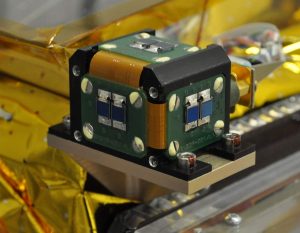A sun sensor is a specialized device used in spacecraft and satellites to detect the position of the Sun relative to the spacecraft’s orientation. By providing precise solar position data, sun sensors are essential for tasks such as attitude determination, solar panel alignment, and overall mission stability.

How a Sun Sensor Works
Sun sensors operate by detecting sunlight and converting it into electrical signals. These signals are processed to determine the angle of incidence, which provides critical information about the Sun’s direction.
Types of Sun Sensors
- Analog Sun Sensors
These sensors use photocells to measure light intensity and determine the Sun’s position. They are simple, reliable, and commonly used in small satellites.
- Digital Sun Sensors
Equipped with advanced optics and processing units, digital sensors offer higher precision by capturing detailed sunlight patterns.
- Coarse Sun Sensors
Designed for basic solar tracking, coarse sun sensors provide general directional information for less complex missions.
- Fine Sun Sensors
These sensors deliver highly accurate measurements, making them ideal for missions requiring precise orientation.
Applications of Sun Sensors
Satellite Attitude Control
The sun sensor plays a crucial role in maintaining satellite stability by providing real-time solar direction data. This enables the satellite to orient itself accurately in space.
Solar Panel Alignment
To maximize energy efficiency, sun sensors help adjust solar panels for optimal sunlight exposure, ensuring consistent power supply for spacecraft systems.
Scientific Instruments
For scientific missions, sun sensors provide critical data to align telescopes or spectrometers with specific celestial targets, enhancing the quality of collected data.
Advantages of Using a Sun Sensor
- High Accuracy
Advanced sun sensors offer precise measurements essential for mission-critical operations.
- Lightweight Design
Compact and lightweight, sun sensors are suitable for small satellites and CubeSats, where weight and space are limited.
- Energy Efficiency
Sun sensors operate with minimal power consumption, conserving resources for other spacecraft systems.
- Durability
Designed to withstand harsh space conditions, sun sensors remain functional under extreme temperatures and radiation exposure.
Challenges in Sun Sensor Design
Space Environment
Sun sensors must endure challenging conditions such as vacuum, temperature fluctuations, and exposure to radiation, necessitating robust materials and designs.
Miniaturization
As the demand for small satellites grows, engineers face challenges in developing compact sun sensors without compromising performance.
Integration
Integrating a sun sensor with other spacecraft systems requires meticulous planning to ensure compatibility and minimize interference.
Advances in Sun Sensor Technology
Recent innovations have significantly enhanced the capabilities of sun sensors:
- Increased Precision: Modern digital sun sensors deliver higher resolution for improved attitude determination.
- AI Integration: Artificial intelligence algorithms optimize data processing, reducing response time and enhancing reliability.
- Advanced Materials: The use of lightweight and durable materials improves performance while reducing overall spacecraft weight.
Choosing the Right Sun Sensor Supplier
Selecting a reliable sun sensor supplier is critical to mission success. When evaluating suppliers, consider the following:
- Proven expertise in space-grade technology
- High-quality components with rigorous testing standards
- Customized solutions to meet specific mission requirements
- Comprehensive support, from design to deployment
By partnering with experienced suppliers, mission planners can ensure the reliability and efficiency of their spacecraft systems, enhancing the overall success of space missions.
